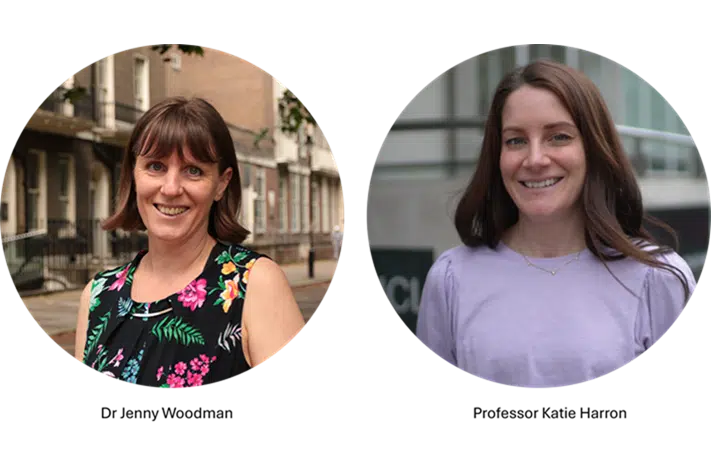8th July 2024
Read our latest Voices blog by Dr Jenny Woodman (Co-Director NIHR Children and Families Policy Research Unit, UCL Institute of Social Research) and Professor Katie Harron (Professor of Statistics and Health Data Science at UCL Great Ormond Street Institute of Child Health) who share the research being carried out in reviewing and comparing health visiting contacts across England.

Over the last 3 years, we have been conducting research describing how health visiting is organised and delivered across England. We found that between April 2018 and March 2020, health visiting teams were reaching nearly all babies and most children under five with face-to-face contacts. In 80% of local authorities, the health visiting service delivered more additional than mandated contacts.
Undoubtedly, even with the high volume of activity outside the mandated contacts, there still exists unmet need in families and a tug of war between a universal service for all families and more intensive provision for families with extra needs. Almost half (45%) of the 1,186 health visitors who completed the latest Institute of Health Visiting survey said that mandated contacts were prioritised over targeted or specialist support in their area, and 79% said that the service lacked capacity to offer a package of support to all children with identified needs.
We also found that the duration and location of visits varied across local areas. Depending on local authority, between 12–30% of mandated contacts were recorded as lasting between 30–44 minutes. This raises a question about whether a mandated review can be adequately conducted in 30-45 minutes, given that it should include direct observation of the child, relationship building with the family, and significant health promotion activity.
There is still a gap between health visiting activity and need. However, our results suggest that, despite challenges with workforce and funding which were already present pre-pandemic, there exists a high coverage and, in some cases, very intense public health infrastructure for under 5s. There is much to build on and reinforce within health visiting in order to use health visiting’s reach and frequency of contact to improve the health and wellbeing of our youngest members of society.
To do this research, we have been using the Community Services Dataset which collates information on health visiting activity in England including date, duration and location of contact. To make sure we understood the content, meaning and context of the health visiting service, we have also been collecting qualitative interview data, speaking to colleagues at the Institute of Health Visiting, to health visiting teams, service leads, commissioners and Directors of Public Health.
The Community Services Dataset should hold information for every baby and preschool child in England, allowing us to compare health visiting activity between local areas and for specific groups of children such as those living in the most deprived neighbourhoods of England. We have been working with data that covers the two-year period from April 2018 to March 2020. This is pre-covid data, recorded prior to the changes that occurred as a result of the COVID-19 pandemic lockdowns (first lockdown, late March 2020).
However, the Community Services Dataset has known problems and NHS England classifies these data as ‘experimental’ (to be used with caution). Based on another source of information about health visiting activity (the health visiting service metrics), we know that lots of the health visiting contacts we would expect to see in the Community Services Dataset are not there. By comparing these two data sources, we identified a set of 57 local authorities with sufficiently complete data to give us a robust picture of health visiting activity for some of England. We have written a technical paper about the missing data in the Community Services Dataset and how we went about finding the local authorities with the most complete data. When we spoke to data teams within local authorities, they suggested lots of ways of improving the Community Services Data but strong leadership and strategic priorities about data came out as key (findings will be available shortly) ).
Our next steps include investigating the content, purpose and experience of contacts from parents and provider perspectives in order to gain a more nuanced picture of health visiting activity (counting contacts is just the beginning). We aim to provide a description of health visiting which can inform conversations about what might be built on and strengthened through modifications and innovation to the service in national and local policy.
You can read our full paper here: Liu, M., Woodman, J., Mc Grath-Lone, L., Clery, A., Bunting, C., Bennett, S., Kendall, S., Kirman, J., Weatherly, H., Barlow, J., Bedford, H. and Harron, K. (2024) “The Variation in health visiting for the under 5s: A cross-sectional analysis of administrative data in England for 2018-2020”, International Journal of Population Data Science, 9(2). https://ijpds.org/article/view/2382/#ref-28
This work discussed in this blog is a team effort across several funded projects involving: Professors Jenny Woodman, Katie Harron and Helen Bedford, Dr Mengyun Liu, Dr Louise Mc Grath-Lone, Dr Eirini Saloniki, Dr Amanada Clery, Catherine Bunting, Dr Jayu Jung, Dr Claire Powell (UCL), Professor Sally Kendall and Dr Rebecca Cassidy (University of Kent), Professor Jane Barlow (University of Oxford), Jennifer Kirman (Oxford Brookes), Professor Helen Weatherly (University of York), Samantha Bennett (Kent County Council).
This work is supported by the National Institute for Health and Care Research (NIHR) Public Health Research Programme (NIHR129901) and Policy Research Programme (NIHR203450). This research has been commissioned by the Department of Health and Social Care to inform policies about supporting the health and wellbeing of babies, young children and their families. The views expressed are those of the author(s) and not necessarily those of the NIHR or the Department of Health and Social Care.

